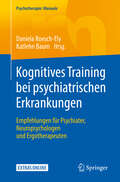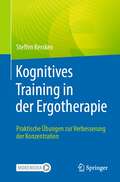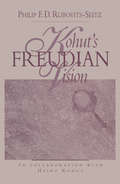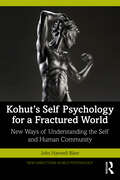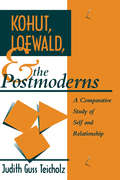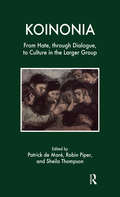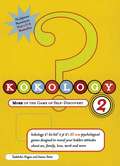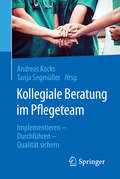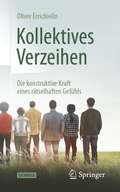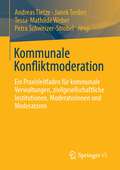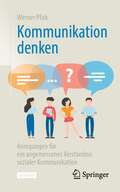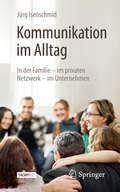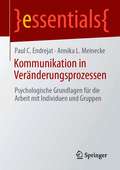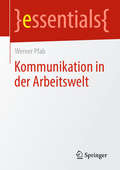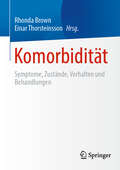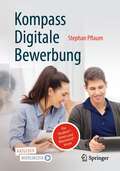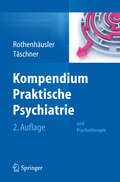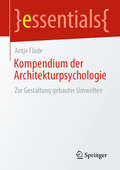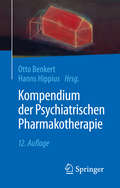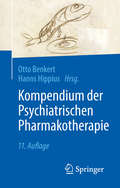- Table View
- List View
Kognitives Athletiktraining im Klettern und Bouldern: Kraft, Ausdauer, Schnelligkeit, Koordination und kognitive Fähigkeiten kombiniert trainieren (Kognitives Athletiktraining)
by Daniel Memmert Jerry MedernachDie Buchreihe Kognitives Athletiktraining informiert in praxisorientierten und wissenschaftlich fundierten Einzelbänden über die Durchführung eines kognitiven Athletiktrainings in verschiedenen Sportarten. Jeder Reihentitel greift eine spezifische Sportart auf und beantwortet die übergeordnete Frage: „Mit welchen Spiel- und Übungsformen kann die Kognition parallel zu Athletik und Kondition trainiert werden?&“ Dabei stehen kognitive Fähigkeiten wie z. B. Wahrnehmung, Kreativität, Antizipation und Aufmerksamkeit sowie konditionelle Fähigkeiten wie Kraft, Ausdauer, Schnelligkeit und Koordination im Fokus. Die Bücher sind didaktisch-methodisch ausgelegt, enthalten viele Beispiele und überzeugen durch eine kompakte und übersichtliche Aufmachung im Theorieteil. Zahlreiche Fotos und Abbildungen erleichtern die Umsetzung der verschiedenen Spiel- und Übungsformen im Praxisteil, der den wesentlichen Anteil der Bücher ausmacht. Die Buchreihe richtet sich insbesondere an Trainer*innen im Leistungs- und Breitensport, an interessierte Sportler*innen sowie an Studierende der Sportwissenschaft. Die Autor*innen der Reihentitel lehren und forschen an Universitäten, sind selbst als Trainer*innen aktiv oder engagieren sich in den Dachverbänden der jeweiligen Sportarten.
Kognitives Training bei psychiatrischen Erkrankungen: Empfehlungen für Psychiater, Neuropsychologen und Ergotherapeuten (Psychotherapie: Manuale)
by Daniela Roesch-Ely Katlehn BaumZahlreiche psychiatrische Erkrankungen gehen mit kognitiven Störungen einher, die die Alltagsfunktionalität der Patienten teils erheblich einschränken. In diesem Buch geben die Herausgeberinnen einen Überblick über kognitive Störungen bei ausgewählten Erkrankungen wie Schizophrenie, affektiven Erkrankungen, adultem ADHS und Autismus-Spektrum-Störungen und präsentieren praxisnahe Empfehlungen zu Planung, Struktur und praktischer Umsetzung entsprechender kognitiver Trainingsprogramme. Abgerundet wird das Manual durch entsprechende Fallbeispiele sowie verschiedene Informations- und Arbeitsblätter, die zum Download zur Verfügung stehen.Dieses Manual entstand in der Psychiatrischen Ambulanz für Kognitives Training (PAKT) des Universitätsklinikums Heidelberg und richtet sich an Psychiater, Neuropsychologen und Ergotherapeuten, die Patienten mit psychiatrischen Erkrankungen und assoziierten kognitiven Defiziten behandeln.
Kognitives Training in der Ergotherapie: Praktische Übungen zur Verbesserung der Konzentration
by Steffen KerskenDieses Praxisbuch liefert alles Wesentliche für das kognitive Training in der Ergotherapie. Welche Assessments sind zur Erfassung der Hirnleistung sinnvoll? Eignet sich eine ergotherapeutische Übung zur Förderung von Konzentration? Wie kann ich meine Patient*innen hinsichtlich Problemlösungs- und Entscheidungsfähigkeit unterstützen? Hier finden Sie die Antworten zu allen Aspekten des Hirnleistungstrainings. Aus dem Inhalt: Kreative und handlungsorientierte Übungen auf Basis eines sechssäuligen Therapiekonzeptes, Berufsbelastungsübungen, Präsentationen und Arbeitsstrategien, Förderung von Konzentration, Belastbarkeit und Aufmerksamkeit, Pausen- und Energiemanagement, Stressbewältigung mit zusätzlichen Arbeitsblättern zum Download.Gönnen Sie sich und Ihren Patient*innen etwas Abwechslung und bereichern Sie Ihr Behandlungsrepertoire um eine Vielzahl von kreativen Übungen.
Kohut's Freudian Vision
by Philip F. Rubovits-SeitzHeinz Kohut was arguably the most influential modern day psychoanalyst. Because current interest in Kohut's work has focused so completely on self psychology, however, certain aspects of Kohut's thinking, in particular his nonreductive synthesis of Freudian theory, are in danger of being lost. Prior to his development of self psychology, Kohut was a legendary teacher of Freudian theory at the Chicago Institute for Psychoanalysis. In this volume, Philip Rubovits-Seitz presents Kohut's previously unavailable lectures from his course on psychoanalytic psychology (prepared in collaboration with Kohut himself) along with an illuminating summary statement on Freudian theory jointly written by Kohut and Rubovits-Seitz.Rubovits-Seitz continues with his own insightful analysis of Kohut's distinctive approach to Freudian theory. And he concludes by arguing persuasively why Kohut's later contributions should best be viewed as a continuation, rather than an abandonment, of this early vision. Kohut's Freudian Vision not only repairs an outstanding tear in received psychoanalytic history but also challenges self psychologists and contemporary Freudian psychoanalysts alike to renewed reflection.
Kohut's Self Psychology for a Fractured World: New Ways of Understanding the Self and Human Community (New Directions in Self Psychology)
by John Hanwell RikerDrawing from Kohut's conceptualisation of self, Riker sets out how contemporary America's formulation of persons as autonomous, self-sufficient individuals is deeply injurious to the development of a vitalizing self-structure—a condition which lies behind much of the mental illness and social malaise of today's world.By carefully attending to Kohut's texts, Riker explains the structural, functional, and dynamic dimensions of Kohut's concept of the self. He creatively extends this concept to show how the self can be conceived of as an erotic striving for connectedness, beauty, and harmony, separate from the ego. Riker uses this distinction to reveal how social practices of contemporary American society foster skills and traits to advance the aims of the ego for power and control, but tend to suppress the needs of the self to authentically express its ideals and connect with others. The book explores the impact that this view can have on clinical practice, and concludes by imaginatively constructing an ideal self-psychological society, using Plato's Republic as a touchstone.Informed by self psychology and philosophy, this book is essential reading for psychoanalysts, psychotherapists and philosophers, seeking to revisit and revise constructions of both self and humanity.
Kohut's Twinship Across Cultures: The Psychology of Being Human (Psychoanalytic Inquiry Book Series)
by Koichi Togashi Amanda KottlerKohut's Twinship Across Cultures: The Psychology of Being Human chronicles a 10-year-voyage in which the authors struggled, initially independently, to make sense of Kohut‘s intentions when he radically re-defined the twinship experience to one of "being human among other human beings". Commencing with an exploration of Kohut’s work on twinship and an illustration of the value of what he left for elaboration, Togashi and Kottler proceed to introduce a new and very different sensitivity to understanding particular psychoanalytic relational processes and ideas about human existential anguish, trauma, and the meaning of life. Together they tackle the twinship concept, which has often been misunderstood and about which little has been written. Uniquely, the book expands and elaborates upon Kohut’s final definition, "being human among other human beings." It problematizes this apparently simple concept with a wide range of clinical material, demonstrating the complexity of the statement and the intricacies involved in recognizing and working with traumatized patients who have never experienced this feeling. It asks how a sense of being human, as opposed to being described as human, can be generated and how this might help clinicians to better understand and work with trauma. Written for psychoanalysts and psychoanalytic psychotherapists interested in self-psychological, intersubjective, and relational theories, Twinship Across Cultures will also be invaluable to clinicians working in the broader areas of psychoanalysis, psychotherapy, social work, psychiatry and education. It will enrich their sensitivity and capacity to understand and treat traumatized patients and the alienation they feel among other human beings.
Kohut, Loewald and the Postmoderns: A Comparative Study of Self and Relationship (Psychoanalytic Inquiry Book Series #No. 18)
by Judith G. TeicholzIn Kohut, Loewald, and the Postmoderns, Judith Teicholz, using the contemporary critique of Kohut and Loewald as a touchstone of inquiry into the current status of psychoanalysis, focuses on a select group of postmodern theorists whose recent writings comprise a questioning subtext to Kohut's and Loewald's ideas. Acutely aware of the important differences among these theorists, Teicholz nonetheless believes that their respective contributions, which present psychoanalysis as an interactive process in which the analyst's own subjectivity plays a constitutive role in the joint construction of meanings, achieve shared significance as a postmodern critique of Kohut and Loewald. She is especially concerned with the relationship - both theoretically and technically -between Kohut's emphasis on the analyst's empathic resonance with the analysand's viewpoint and affect, and the postmodern theorists' shared insistence on the expression of the analyst's own subjectivity in the treatment situation. Her analysis incorporates fine insight into the tensions and ambiguities in Kohut and Loewald, whose work ultimately emerges as a way station between modern and postmodern viewpoints, and her appreciation of Kohut and Loewald as transitional theorists makes for an admirably even-handed exposition. She emphasizes throughout the various ways in which Kohut and Loewald gave nascent expression to postmodern attitudes, but she is no less appreciative of the originality of postmodern theorists, who address genuine lacunae in the thought and writings of these exemplars of an earlier generation. Teicholz's examination of what she terms two overlapping "partial revolutions" in psychoanalysis - that of Kohut and Loewald on one hand and of the postmoderns on the other - throws an illuminating searchlight on the path psychoanalysis has traveled over the last quarter of the 20th century.
Koinonia: From Hate, through Dialogue, to Culture in the Larger Group
by Patrick De Maré Robin Piper Sheila ThompsonA study of the larger group, focusing on the processes and dynamics whereby the group micro-culture emerges. As the initial frustrations of the group find expression in hate, this is transformed through dialogue to what the Greeks knew as ‘koinonia’, or the state of impersonal fellowship. Essentially, Koinonia concerns itself with an operational approach to dialogue, culture and the human mind through the medium of a larger group context, and adopts a direction similar in many ways to the groupanalytic method of S. H. Foulkes. In attempting to link the most intimate aspect of individual beings naturally and spontaneously in the socio-cultural setting of the larger group, by the very nature of its size, offers a structure or medium for linking inner world with cultural context, and is thus able to establish a unique dimension – that of the micro-culture. Until now neither psychoanalysis nor small groups have been able to handle this aspect empirically, since, in the former, the analyst represents the assumed culture, while in the small group situation the hierarchy of the family culture inevitably prevails. The larger group displays the other side of the coin to the inner world, namely the socio-cultural dimension in which interpersonal relationships take place. The exploration of this field shows how objects, including part objects of the mind, can be related to systems and structures in a manner not previously attempted, and raises the vexed question of the relationship of systems to structures and of culture to social context. In this study of the larger group, particular attention is paid to the processes and dynamics whereby the group micro-culture emerges, as the initial frustrations of the group find their expression through hate; as hate initiates, and is transformed by, dialogue; and as dialogue ultimately establishes what the Greeks knew as ‘koinonia’, or the state of impersonal fellowship.
Kokology 2
by Tadahiko Nagao Isamu SaitoKokology 2 offers all-new insights into the surprising real you. Kokology, the popular Japanese pop-psych quiz game, is now an American bestseller, and Kokology 2 offers more than 50 all-new quizzes, perfect for beginners and experienced kokologists alike. Kokology, the study of kokoro ("mind" or "spirit" in Japanese), asks you to answer questions about seemingly innocent topics -- such as which is the cleanest room in an imaginary house? -- and then reveals what your answers say about you. Play it alone as a quest of self-discovery, or play with friends, if you dare!
Kollegiale Beratung im Pflegeteam: Implementieren - Durchführen - Qualität sichern
by Andreas Kocks Tanja Segmüller Kim Oliver TietzePflegende müssen schwierige Situationen häufig allein bewältigen; gezielter Rat im Kollegenkreis wird meist nur beiläufig „Zwischen-Tür-und-Angel“ gesucht. Für eine gleichbleibende Pflegequalität und gesunde Mitarbeiter ist jedoch ein gezielter und professioneller Austausch bei belastenden Situationen notwendig. Eine systematische Methode der gegenseitigen Unterstützung stellt die „kollegiale Beratung“ dar.Ausgearbeitet von der Sektion „Beraten, Informieren, Schulen“ (BIS) der Deutschen Gesellschaft für Pflegewissenschaft (DGP) finden Sie als professionell Pflegende, Pflegemanager oder Pflegepädagoge für die Einführung und Umsetzung dieser Beratungsmethode das notwendige Handwerkszeug.
Kollektives Verzeihen: Die konstruktive Kraft eines rätselhaften Gefühls
by Oliver ErrichielloDas kollektive Verzeihen steht in seiner Rätselhaftigkeit der Liebe in nichts nach. Wir Menschen sind unergründliche Wesen. Zwar agieren wir meist bedächtig und rational und doch lassen sich viele Handlungen und Entscheidungen scheinbar nicht logisch herleiten. Das Verzeihen – jeder kennt es und hat es erfahren – gehört dazu. Verzeihen ist eines der wichtigsten und spannendsten Phänomene menschlicher Kommunikation. Das Buch beantwortet Fragen wie: Warum verzeihen wir einigen Menschen und anderen nicht? Warum braucht Verzeihen Zeit? Warum verzeihen Menschen einander seit jeher – oder lehnen eben gerade den Akt des Verzeihens ab? Verzeihen wir einzelnen Menschen im persönlichen Umfeld leichter oder schwerer als einer Gruppe von Menschen? Und vor allem: Warum ist das kollektive Verzeihen zeit- und kulturübergreifend wirksam? Im Zeitalter der hyperkomplexen und total vernetzten Welt, die keine Pausen mehr kennt, ist Verzeihen unerlässlich. Das Buch regt zum Nachdenken an und bietet wertvolle Impulse, um das eigene und das soziale Handeln besser zu verstehen.
Kommunale Konfliktmoderation: Ein Praxisleitfaden für kommunale Verwaltungen, zivilgesellschaftliche Institutionen, Moderatorinnen und Moderatoren
by Andreas Tietze Janek Treiber Tessa-Mathilde Weber Petra Schweizer-StrobelDer Band fasst in kompakter und verständlicher Form die wesentlichen Aspekte von Veranstaltungs- und Konfliktmoderation zusammen und richtet sich damit an all diejenigen, die an der Ausrichtung von Dialog- und Beteiligungsformaten interessiert sind. Diese sollen befähigt werden, eigene Diskussionsformate durchzuführen und erfolgversprechend zu moderieren. Ohne entsprechendes Vorwissen und bestimmte Planungsschritte scheitern Moderationsversuche oft oder liefern nicht die gewünschten Ergebnisse. Derlei Situationen sollen mit Hilfe des Buches vermieden werden. Es bildet das Resultat jahrelanger theoretischer und praktischer Arbeit auf dem Feld von Veranstaltungsplanung, -durchführung und insbesondere -moderation. Nach einem einführenden Teil zu Aspekten von Sprache, Rhetorik, nonverbaler Kommunikation und dem Umgang mit eigenen inneren Widerständen, werden Vorbereitung, Durchführung und Nachbesprechung von Moderationen diskutiert und in verschiedenen Facetten vorgestellt. Welche Veranstaltungsorte eignen sich, welche nicht? Welche Diskussionsformate sind in welcher Situation angemessen? Wann ist welcher Moderationsstil anzuwenden? Diese und weitere Fragen werden in den verschiedenen Kapiteln beantwortet. Ergänzt wird das Handbuch durch umfangreiches Material aus der Praxis.
Kommunikation denken: Anregungen für ein angemessenes Verständnis sozialer Kommunikation
by Werner PfabDas Buch präsentiert das Thema Kommunikation allgemeinverständlich und essayistisch und liefert ein fundiertes Verständnis zwischenmenschlicher Kommunikation auf psychologischer und kulturwissenschaftlicher Grundlage. Es setzt bei gängigen Vor-Urteilen über Kommunikation an, erläutert die historischen und kulturellen Umstände, unter denen sie entstanden sind, und stellt dann auf psychologischer Basis wesentliche Gesichtspunkte zwischenmenschlicher Kommunikation dar. Daraus werden Anforderungen abgeleitet, mit denen man sich in Kommunikation auseinandersetzen muss sowie Anregungen für eine produktive und befriedigende Kommunikationspraxis gegeben.
Kommunikation im Alltag: In der Familie - im privaten Netzwerk - im Unternehmen
by Jürg IsenschmidTagtäglich sind wir Teil eines kommunikativen Prozesses – sei dies in der Familie, mit Freunden oder am Arbeitsplatz. Nicht immer eine einfache Sache – ab und an sind wir hierbei mit Situationen konfrontiert, die zu Störungen und Disharmonie führen können. Jürg Isenschmid versteht es, unser Verhalten in den unterschiedlichsten sozialen Gefügen anschaulich zu analysieren und uns erkennen zu lassen, dass jeder dazu beitragen kann, ein friedliches Miteinander zu gestalten – auch Sie!
Kommunikation in Veränderungsprozessen: Psychologische Grundlagen für die Arbeit mit Individuen und Gruppen (essentials)
by Annika L. Meinecke Paul C. EndrejatDieses essential zeigt, wie die Kommunikation in organisationalen Veränderungsprozessen erfolgreich gestaltet werden kann. Es baut auf psychologischen Theorien und dem Kommunikationsansatz der Motivierenden Gesprächsführung auf, um konkrete Handlungsempfehlungen für die organisationale Praxis zu bieten. Diese Empfehlungen werden anhand von Mitarbeitergesprächen und der Arbeit mit Gruppen illustriert. Der Fokus liegt darauf, wie die Veränderungsunterstützung der Mitarbeitenden nachhaltig gefördert werden kann.
Kommunikation in altersgemischten Teams: Forschungsstand und -perspektiven (essentials)
by Michaela Moser Bettina FührmannDieses essential beschreibt den Einfluss einer altersgemischten Gruppenzusammensetzung auf die Kommunikation im Teamkontext. Unterschiedliche Denk- und Arbeitsweisen sowie gegenseitige Altersstereotype bergen Kommunikationsprobleme, die eine erfolgreiche Teamarbeit behindern. Zur Vermeidung dieser Effekte und zur Nutzung des Innovationspotenzials altersheterogener Teams ist ein tieferes Verständnis der kommunikativen Prozesse und Dynamiken in altersgemischten Teams erforderlich.
Kommunikation in der Arbeitswelt (essentials)
by Werner PfabIn diesem Essential werden wesentliche arbeitsbezogene Aspekte zwischenmenschlicher Kommunikation erläutert, u.a. die Einbindung in die jeweilige Arbeitskultur, das Moment wechselseitiger Abhängigkeit, der Inszenierungs-, Macht- und paradoxe Charakter. Ferner wird die Wirkungsweise wichtiger Gesprächsformate (u.a. Arbeitsbesprechung, Kundengespräch) erklärt und es werden Anregungen für eine angemessene Kommunikationspraxis gegeben.
Komorbidität: Symptome, Zustände, Verhalten und Behandlungen
by Einar Thorsteinsson Rhonda BrownDieses Buch stellt eine neue Theorie über die erhebliche Komorbidität vor, die zwischen vielen Krankheiten und Störungen und gleichzeitigen Symptomen wie Schmerzen, Schlafstörungen und Müdigkeit besteht. Zu den besprochenen Krankheiten und Störungen gehören Adipositas, Diabetes mellitus Typ II, medizinische Erkrankungen wie Herz-Kreislauf-Erkrankungen und Schlafstörungen, Essstörungen sowie affektive Störungen (Angst und Depression). Das Buch geht davon aus, dass die Komorbiditäten das Ergebnis eines komplexen bio-psycho-behavioralen Mechanismus sind, der eine Störung des zirkadianen Rhythmus einschließt. Es untersucht methodische (z. B. Mess-) Probleme, die das Verständnis der Komorbidität erschweren können, und erforscht ein breites Spektrum neuer, bestehender und neu entwickelter Therapieansätze, die bei der Behandlung komorbider Störungen von Nutzen sein könnten.
Kompass Digitale Bewerbung: Für Student*innen und Absolvent*innen
by Stephan PflaumDieses Arbeitsbuch für Studierende und Absolventinnen aller Fachbereiche führt Sie wie ein Kompass durch den Bewerbungsprozess vom Praktikum bis zum ersten Job nach dem Studium. Zahlreiche Checklisten zum Ausfüllen und Reflektieren erleichtern Ihnen den Prozess.In den letzten beiden Jahren hat sich viel verändert. So schwer die Pandemie die Gesellschaft in allen Teilen getroffen hat, so sehr hat sie auch die Prozesse der Digitalisierung in allen Lebensbereichen weitergetrieben. Auch in Bewerbungsverfahren hat sich vieles geändert. Während die blaue papierlederne Bewerbungsmappe mit goldenen Lettern schon länger der Vergangenheit angehört, hat sich nun auch der übrige Bewerbungsprozess weiter digitalisiert: vom Video-Interview bis hin zur remote Einarbeitung.
Kompendium Praktische Psychiatrie
by Karl-Ludwig Täschner Hans-Bernd RothenhäuslerDas Fachbuch für Studium und Praxis bietet eine übersichtliche Einführung in Psychiatrie und Psychotherapie. Dargestellt werden das Arbeitsfeld der Psychiatrie, die psychopathologische Befunderhebung, diagnostische und therapeutische Prinzipien sowie die psychiatrischen Krankheitsbilder. Die Autoren betrachten auch spezielle Aspekte: Notfall-, Kinder- und Jugend- sowie Konsiliarpsychiatrie. Für die 2. Auflage wurden alle Inhalte aktualisiert und um typische Fallgeschichten erweitert. Außerdem neu: umfangreicher Anhang, u. a. mit 100 Prüfungsfragen.
Kompendium der Architekturpsychologie: Zur Gestaltung gebauter Umwelten (essentials)
by Antje FladeDieses essential liefert planungsrelevante Informationen über architekturpsychologische Konzepte und empirische Ergebnisse zu den Wirkungsweisen gebauter Umwelten auf den Menschen und liefert Hinweise, wie die Beziehungen zwischen Mensch und gebauter Umwelt optimiert werden können.
Kompendium der Psychiatrischen Pharmakotherapie
by Otto Benkert Hanns HippiusSeit Jahrzehnten der unangefochtene Bestseller für die Psychopharmakotherapie!Seit nunmehr 12 Auflagen steht das Buch für Verlässlichkeit und Kompetenz.In der Neuauflage wurden sämtliche Inhalte sorgfältig überarbeitet und auf den neuesten Stand gebracht. Selbstverständlich finden Sie alle neuen Präparate mit den aktuellsten Empfehlungen und Bewertungen und die Berücksichtigung der DSM-5 Klassifikation.Das „Kompendium der psychiatrischen Pharmakotherapie“ ist der unverzichtbare Leitfaden für die Psychiatrie. Nirgendwo sonst findet man so komprimiert alles Wissenswerte rund um die Psychopharmakotherapie PLUS alles Wesentliche zu den einzelnen psychischen Störungen.Begleitend zum Buch gibt es einen kostenfreien Psychopharmaka-Blog (Kompendium News), der Sie über Neuerungen auf dem Laufenden hält, und den „Pocket Guide Psychopharmaka“, die ganz kleine und schnelle Variante für die Kitteltasche.
Kompendium der Psychiatrischen Pharmakotherapie
by Otto Benkert Hanns HippiusSeit Jahrzehnten der unangefochtene Bestseller für die Psychopharmakotherapie!Verlässlichkeit und Kompetenz zeichnet auch die 14. Auflage des Kompendiums aus. In der Neuauflage wurden sämtliche Inhalte sorgfältig überarbeitet und auf den neuesten Stand gebracht. Selbstverständlich finden Sie alle neuen Präparate mit den aktuellsten Empfehlungen und Bewertungen und die Berücksichtigung der DSM-5 Klassifikation.Das „Kompendium der psychiatrischen Pharmakotherapie“ ist der unverzichtbare Leitfaden für die Psychiatrie. Nirgendwo sonst findet man so komprimiert alles Wissenswerte rund um die Psychopharmakotherapie PLUS alles Wesentliche zu den einzelnen psychischen Störungen.
Kompendium der Psychiatrischen Pharmakotherapie
by Otto Benkert Hanns HippiusSeit Jahrzehnten der unangefochtene Bestseller für die Psychopharmakotherapie!Mit der inzwischen 13. Auflage steht das Buch einmal mehr für Verlässlichkeit und Kompetenz. In der Neuauflage wurden sämtliche Inhalte sorgfältig überarbeitet und auf den neuesten Stand gebracht. Selbstverständlich finden Sie alle neuen Präparate mit den aktuellsten Empfehlungen und Bewertungen und die Berücksichtigung der DSM-5 Klassifikation.Das „Kompendium der psychiatrischen Pharmakotherapie“ ist der unverzichtbare Leitfaden für die Psychiatrie. Nirgendwo sonst findet man so komprimiert alles Wissenswerte rund um die Psychopharmakotherapie PLUS alles Wesentliche zu den einzelnen psychischen Störungen.Begleitend zum Buch gibt es einen kostenfreien Psychopharmaka-Blog (Kompendium News), der Sie über Neuerungen auf dem Laufenden hält. Jetzt erstmals in einem neuen Buchformat und mit angepasstem, modernem Layout.
Kompendium der Psychiatrischen Pharmakotherapie
by Otto Benkert and Hanns HippiusSeit Jahrzehnten der unangefochtene Bestseller für die Psychopharmakotherapie!Seit nunmehr 11 Auflagen steht das Buch für Verlässlichkeit und Kompetenz.In der Neuauflage wurden sämtliche Inhalte sorgfältig überarbeitet und auf den neuesten Stand gebracht. Selbstverständlich finden Sie alle neuen Präparate mit den aktuellsten Empfehlungen und Bewertungen.Das „Kompendium der psychiatrischen Pharmakotherapie“ ist der unverzichtbare Leitfaden für die Psychiatrie. Nirgendwo sonst findet man so komprimiert alles Wissenswerte rund um die Psychopharmakotherapie PLUS alles Wesentliche zu den einzelnen psychischen Störungen.Begleitend zum Buch gibt es einen kostenfreien Psychopharmaka-Blog (Kompendium News), der Sie über Neuerungen auf dem Laufenden hält, und den „Pocket Guide Psychopharmaka“, die ganz kleine und schnelle Variante für die Kitteltasche.

